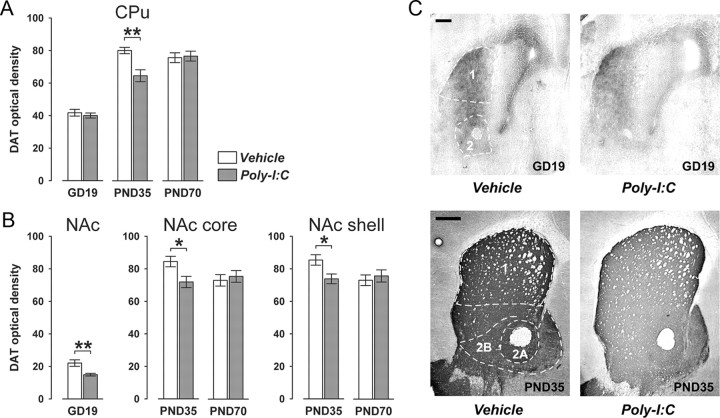Figure 4.
Age- and region-specific reduction in striatal DAT expression following prenatal immune challenge. Pregnant mice were exposed to the viral mimic Poly-I:C or vehicle treatment, and the effects on striatal DAT expression were investigated in the resulting offspring at the fetal (GD19), peripubertal (PND35), and adult (PND70) stages of development using optical densitometry of immunohistochemically stained coronal brain sections. A, Offspring born to Poly-I:C-treated mothers displayed a significant decrease in DAT immunoreactivity in the CPu specifically at peripubertal age in comparison with age-matched offspring born to vehicle-treated control mothers. **p < 0.01, based on Fisher's LSD post hoc group comparison of PND35 specimen following the presence of a significant two-way interaction in the initial 2 × 3 (prenatal treatment × age) ANOVA (F(2,63) = 5.60, p < 0.01). B, Prenatal Poly-I:C exposure also led to a significant reduction in DAT immunoreactivity in the fetal NAc region compared with fetuses derived from control mothers. *p < 0.05, based on one-way ANOVA with the between-subjects factor of prenatal treatment ANOVA (F(1,21) = 10.36, p < 0.01). In addition, peripubertal (but not adult) offspring born to Poly-I:C-treated mothers showed a significant reduction in DAT immunoreactivity in both the NAc core and shell subregions relative to peripubertal control offspring. *p < 0.01, based on Fisher's LSD post hoc group comparison of PND35 specimen following the presence of a significant two-way interaction in the initial 2 × 2 (prenatal treatment × postnatal age) ANOVA (NAc core: F(1,42) = 4.72, p < 0.05; NAc shell: F(1,42) = 4.56, p < 0.05). C, Representative images of coronal brain sections of fetal (GD19) and peripubertal (PND35) offspring derived from vehicle- or Poly-I:C-treated mothers stained for DAT by immunohistochemistry. 1, CPu; 2, NAc; 2A, NAc core; 2B, NAc shell. Scale bars, 500 μm. All values in A and B are means ± SEM. The numbers of offspring included in the analyses were N(GD19-vehicle) = 12, N(GD19-Poly-I:C) = 11, N(PND35-vehicle) = 12, N(PND35-Poly-I:C) = 11, N(PND70-vehicle) = 11, N(PND70-Poly-I:C) = 12.

